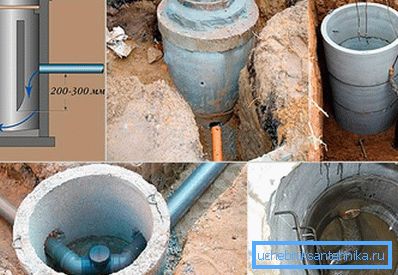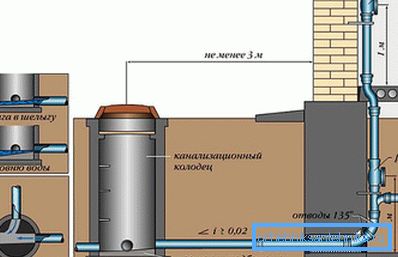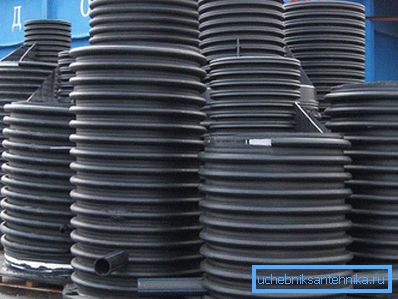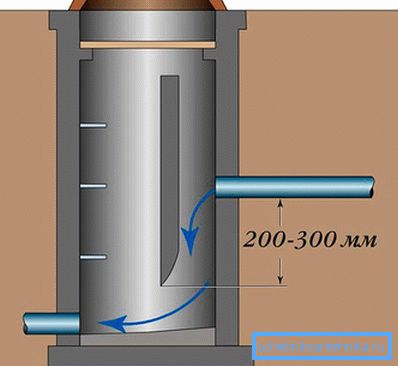How to make a sewer well yourself
Today, few will agree to live in a country house without amenities. Heating, plumbing and sewage system is in almost every household. But sometimes the creation of such communications requires considerable expenses. For example, it is necessary to install wells for the sewage system, which means to spend family finances on hiring workers or buying finished products. But you can do without these costs. In this article we will talk about how to make a sewer well with your own hands.
Types of wells and their location

Before you talk about how to build a well in the country or on a plot of a country house with your own hands, you should learn about their varieties. The following types of structures can participate in the sewage system:
- Inspection or control well. It is arranged on straight and long sections of the sewer line. With the help of a manhole, they monitor the operation of the system and, if necessary, clean the pipes.
- Turning. When designing a sewage system, it is undesirable to make turns, because in such places there is a high probability of blockages. But sometimes bends can not be avoided. In this case, make rotary wells.
- Nodal. If it is necessary to make a fork or connect several sewer systems, nodal wells are built.
- Delta. If the site has a difficult terrain, then in some areas a strong drop in the level of pipe laying may form. To avoid this, drop wells are built.
- Cumulative and filtration. Such structures are the end points of sewer systems. They collect all waste water for further treatment or disposal.

The location of the structure will depend on its purpose. If a nodal, differential and rotary well build according to the sewage scheme, then the viewing and accumulative need to be located in accordance with existing standards.
The inspection well must be placed at a distance of not less than 3 and not more than 12 meters from the exit of the pipe from the house. Also, the distance between them should not exceed 15 meters. Cumulative or filtration well build away from drinking water sources. So according to the SNiP, the distance to the well, from where they take should not be less than 30 meters.
In addition, to the storage well should be free access of vehicles. From it, it is necessary to periodically pump out the accumulated sewage using a sewage truck.
What material to choose

If the choice of location was determined, then it is worth thinking about what the well will be built from. Everything will depend on the financial possibilities and availability of materials. For the construction of sewer wells are used:
- brick;
- reinforced concrete;
- tree;
- plastic.
In practice, you can build from different materials. Very often you can find sewer wells, lined with used bricks or concrete poured. Reinforced concrete rings are quite common. Also there are structures, the walls of which are made of wooden boards, impregnated with a special solution against rotting. In rural areas, automobile or tractor tires are very often used.

If you have enough money, you can purchase finished plastic products. Such wells, made in the factory, meet all sanitary standards and can serve for many decades.
Construction process

Work on the creation of sewer wells will depend on their purpose. Inspection, turning and nodal will have a similar structure. They are based on a sealed container with two or more incoming and outgoing pipes. The depth of such a well will be slightly greater than the depth of the sewer pipes.
The differential well has a differential well. There will also be an airtight container, but unlike the previous options, the level of the inlet pipe and the outlet will not be the same. It will also be necessary to make a lowering. It will consist of a straight cross, tuba and knee. When using plastic pipes, the connection is made at an angle of 45 degrees; if the pipes are cast iron, the angle should be 135 degrees. The cross is needed to inspect the pipes and remove blockages.

The filter well is a tank without a bottom. Under it, arrange a cushion of rubble, through it drains seep into the ground, and solid impurities accumulate in the well. If an accumulation well is installed on the site, then it is made completely airtight. These are the requirements of sanitary standards.
It is also important to install a ventilation pipe. It is mounted on the accumulative and filtering wells. From above, any structure is equipped with a hatch, for pumping sewage or carrying out repair work.
Video
This video shows how to make a well from concrete rings with your own hands: